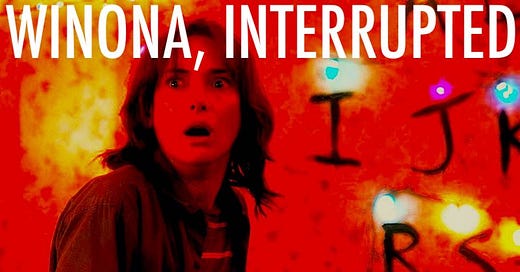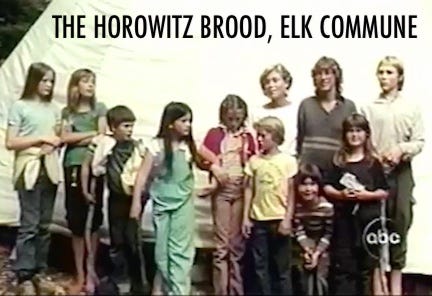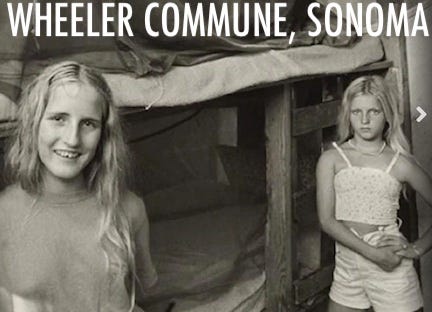Winona, Interrupted: Little Girl Lost
Open Season on kids in the predators' paradise of Post-Hippie California
After more than a decade as a scapegoat in the gossip columns and as a punchline in Hollywood, and after more than a decade marked by public ridicule and increasingly low-profile gigs, Winona Ryder staged a remarkable comeback in 2016 at the age of 45, practically geriatric for any actress in Hollywood.
And as it happens, Joyce Byers — distraught mother of an abducted child — was a role Winona was born to play.
Remember that the first Stranger Things was nothing like what the series eventually became — it was a dark and paranoid allegory on the abuses of programs like MKULTRA and the destructive effects they unleashed on vulnerable children.
The question then becomes, how much of this directly connects to Winona's own history — ie., the history we haven't yet heard, but can obviously see the painful aftereffects of nonetheless?
Winona has always been courageously open about her ongoing struggles with anxiety and depression — she’s said she began experiencing panic attacks as early as age 12. These intensified in her late teens, and she finally checked herself into a psych ward in 1990 to seek relief from severe panic attacks and insomnia. As with nightmares (which we'll get to in a bit), these are both telltale symptoms of childhood sexual abuse.
Her 1993 breakup with Johnny Depp triggered what she later called her "real-life Girl, Interrupted," referring to the 1999 film which she starred in and produced.
In the light of Winona's early typecasting as a child bride, let's have a quick look at the author of Girl, Interrupted:
Susana Kaysen was a bright but troubled teenager who had already abandoned school, had an affair with her high school English teacher, and half-heartedly attempted suicide.
Kaysen was born and raised in Cambridge, Massachusetts. She is the daughter of Annette (Neutra) and economist Carl Kaysen, a professor at MIT and former advisor to President John F. Kennedy.
Huh. Interesting story for Winona to feel drawn to, don’t you think?
Remember also that MIT was a big player when it came to MK work. And of course, remember that MKULTRA played a major role in the San Francisco drug culture from which Winona was sprung.
THE DARK SIDE OF THE RAINBOW
Possibly out of deference to her parents, Winona often described her early experiences in the Elk Rainbow commune in idyllic terms, but has also vaguely alluded to "terrible memories" as well. Either way, it's obvious that her parents were permissive to the extreme. And given their work as hallucinogen advocates, unsurprisingly tolerant of illegal drug use.
Winona: How I was raised was, there were no rules—nothing like that. If I wanted to take a drug because I was in school and everybody was doing it, I could go to my parents and say, “I really want to try this.” And they’d say, “If you do this, O.K., but this is what can happen to you…”
Other significant GenX stars were raised in similar circumstances. The effects of such an upbringing probably didn't do them many favors:
Courtney Love: Born to therapist Linda Carroll and Grateful Dead associate Hank Harrison, the black widow's childhood was characterized by a nomadic lifestyle, moving frequently and living in communes in Oregon and New Zealand.
River Phoenix: Raised in the Children of God group, a worldwide pedophile ring masquerading as a church. His family traveled through communes in Mexico and Venezuela and his childhood was marked by a "unconventional" nomadic lifestyle.
Rose McGowan: Also raised the Children of God sect (her father ran the Italian chapter). McGowan and her family lived in various communes until they left the cult in 1978.
Alexis Arquette: Like xer/xis siblings (David, Patricia, and Rosanna), Alexis was raised in a Subud commune in Virginia (Subud is a syncretic spiritual practice, similar to Ba'hai). Their time in this community shaped their early years, with Alexis later becoming an actress and trans activist before dying of HIV-related myocarditis in 2016.
A lot of people who were raised in those environments have come to decry them. The stories often focus on the neglect, which is not only psychologically damaging to children, but also leaves them exposed to danger. It's largely a forgotten story in the Age of GenX Erasure, but the evidence is there if you look for it.
Based on the memoir The Hypocrisy of Disco by Clane Haywardo, (the film Lane 1974) tells the story of Lane, a 13-year-old girl living with her mother and siblings in very raw circumstances. The family starts off in a commune… (w)hen they’re kicked out, they join another mom and her kids for life on the beach.
The crux of the film lies in the relationship between mother and daughter. Hallelujah rejects all of society’s structures and mores and yearns to just meditate and connect her consciousness to the universe. That’s all fine but does not serve her daughter well. The single-minded focus of the parent to the exclusion of the child is difficult to watch.
Then this, from an interview with Marcy Strongheart, author of A Boy Named Trout.
Q: Why did you want to write this book?
A: On the back cover of the book is the dictum "If it feels good, do it," which is a hippie saying. But how a lot of people took that quite literally was, "If something gives you pleasure, then it is inherently morally good." I have a lot of friends who were given hallucinogens at 2, 3, 4 years old.
I've never gotten the warm and fuzzies in my reading on communes when it comes to responsible parenting, especially considering some of the more extreme ideas about kids circulating amongst sexual revolutionaries and big-name intellectuals of the time. Kids on some communes were often exposed to 24/7 rutting, and many places would invite any old Tom, Dick or Harry who showed up at their gates to join the communities.
It's hard to quantify, given the anti-authority ethos of the hippie communards and the lack of internal rigor when it came to recording problematic events and behaviors, but it's out there.
From the Guardian:
It’s only natural that the children of the counterculture are ambivalent about its demise. ,,, The 1999 non-fiction book Wild Child: Girlhoods in the Counterculture, portrays a broad range of views, with some contributors, such as Elizabeth Shé, completely rejecting their parents’ values.
“The free love movement,” Shé wrote, “set me up for a lifetime of sexual, emotional and physical abuse.”
This taken from the paper, Child Sexual Abuse: Secrecy & Isolation:
One male survivor I know lived in a hippie commune during his entire childhood. He became the object of sexual abuse for many different members of the commune. He became “community property,” as he put it.
“Hippie communes don’t call the police” he said sadly. “There was never any danger of anyone being punished for f-cking my body.”
So what then do we make of the fact that Winona began experiencing serious mental and emotional issues — including chronic nightmares — before she even hit puberty?
Maybe her time in Elk wasn't nearly as idyllic as she would like to believe…
Keep reading with a 7-day free trial
Subscribe to THE SECRET SUN EXTENSION SCHOOL to keep reading this post and get 7 days of free access to the full post archives.






